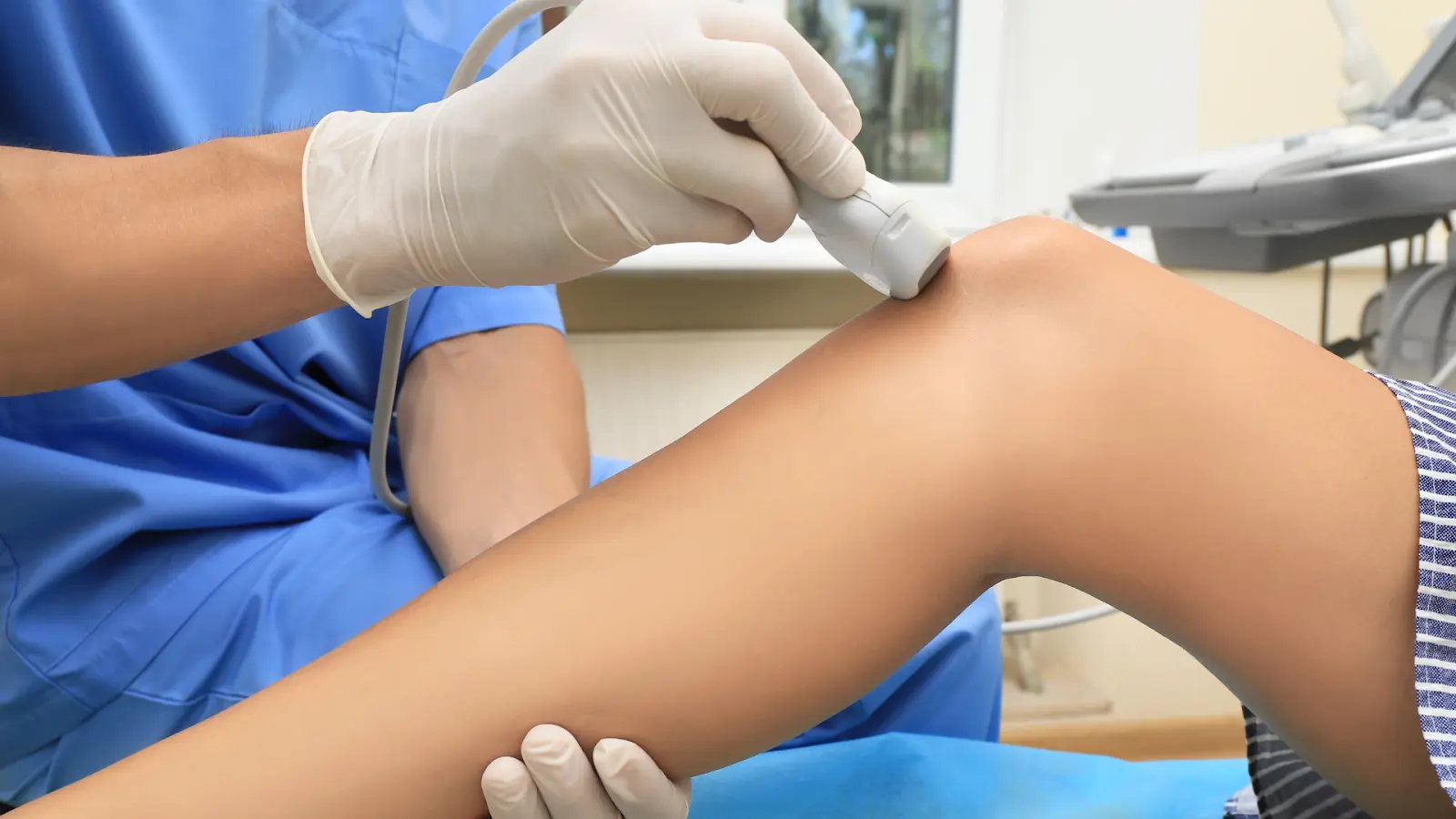
Viscosupplementation, a treatment for knee osteoarthritis, involves injecting hyaluronic acid into the joint to lubricate and cushion it. While some studies report pain relief and improved function, others find the benefits clinically insignificant. This discrepancy highlights the need for individualized treatment plans.
Monovisc and Durolane are two viscosupplements used in this treatment approach. Monovisc is a single-injection formula, whereas Durolane requires multiple injections. Both aim to relieve pain and improve knee mobility, but their effectiveness can vary from patient to patient.
In this article, we will explore these treatments in depth. We’ll analyze their formulations, dosing regimens, and clinical outcomes to help readers make informed decisions about managing their knee osteoarthritis.
Key Takeaways
- Monovisc and Durolane contain hyaluronic acid to help with knee pain from osteoarthritis.
- Both treatments aim to improve the knee joint’s function by acting like the body’s lubricating fluid. But they differ in how many injections you might need—Monovisc just once compared to possibly more with Durolane.
- Choosing between them is not just about which works best but also about the cost and what better fits someone’s treatment plan or budget. The actual cost still varies, especially if you have insurance coverage for these treatments.
About: DoctorMedica is your trusted supplier of top-quality dermal fillers, viscosupplements, and more for your medical practice. We offer genuine products from leading brands at the lowest prices in the market. If you’re looking to buy Monovisc wholesale for your practice, the sales representatives at Doctor Medica can give you guidance.
Introduction to Monovisc and Durolane

Knee osteoarthritis is a joint condition that can cause pain and stiffness in the knee. It happens when the protective cartilage on the ends of bones wears down over time. This issue is common among older adults but can also affect younger people due to injury or other conditions.
Viscosupplementation is a crucial method doctors use to ease joint pain and improve mobility in people with osteoarthritis. This process involves injecting a lubricating fluid similar to the one naturally found in joints directly into the affected area.
Monovisc and Durolane are viscosupplements, each leveraging hyaluronic acid to ease joint pain in osteoarthritis patients. They inject lubricating fluid into the knee to mimic the body’s synovial fluid.
Composition and Mechanism of Action
Monovisc is made of hyaluronic acid. This fluid acts like the natural lubricant in healthy knee joints, helping the knees move smoothly. Monovisc acts like a lubricant and shock absorber in the knee. It uses hyaluronic acid, similar to the fluid naturally found in joints. This treatment helps knees move smoothly, reducing pain from osteoarthritis.
Like Monovisc, Durolane comes into play when easing joint pain caused by osteoarthritis is needed. Durolane might be priced higher than Monovisc, reflecting its approach and composition, which is designed for those seeking alternatives in pain management therapy with potentially fewer injections required over time.
Durolane works by mimicking natural joint fluid, which helps joints move smoothly. It has hyaluronic acid, like the body’s own joint lubricant. When injected into a knee with osteoarthritis, it adds to the joint’s natural fluids.
Clinical Efficacy
Monovisc has an average rating of 4.4 out of 10 on Drugs.com, suggesting mixed reviews about its effectiveness in clinical settings. Doctors have seen various results with Monovisc. However, there are mixed reviews from patients who tried it, suggesting that some find relief from knee osteoarthritis pain while others may not see as much benefit.
Durolane has shown some promise in clinical trials for treating knee osteoarthritis. Studies point out that Durolane, like other viscosupplements, aims to reduce pain and improve joint function by mimicking the body’s synovial fluid.
With Durolane’s varying yet high price, expectations for significant pain relief are high. Similar to Monovisc, patient reviews are a mix of positive and negative ones, with some claiming that it has significantly reduced joint pain caused by osteoarthritis. Unfortunately, some have moved on from this treatment since they weren’t able to achieve pain relief from Durolane.
Practical Considerations

Monovisc stands out for its simple dosing schedule. It requires just a single injection to deliver relief from knee osteoarthritis pain. This makes it a convenient option for both patients and medical professionals.
Durolane may require more than one shot to work best. This process means for some patients, a single dose does just fine; for others, they might need another injection after a while. The plan depends on how the patient’s knee responds.
Administration Techniques
- Confirm the patient’s diagnosis of knee osteoarthritis. Healthcare professionals can also discuss other treatments to give their patients a bigger picture. During a consultation, they can discuss Monovisc vs. Euflexxa or Durolane to find which best aligns with their health goals.
- Gather all necessary materials before the procedure, including the pre-filled syringe, gloves, antiseptic swabs, and sterile drapes.
- Have the patient sit or lie comfortably, allowing easy knee access.
- Clean the injection area with antiseptic swabs to minimize infection risk.
- Use a local anesthetic if needed to reduce discomfort during injection.
- Carefully remove the cap from the syringe, avoiding contact with the tip to keep it sterile.
- Insert the needle into the knee joint space, following proper anatomical landmarks to ensure correct placement.
- Slowly inject all the product into the joint space; this process should be gentle to minimize patient discomfort.
- Once the injection is complete, remove the needle from the knee and adequately dispose of it in a sharps container.
- Apply a small bandage over the injection site if there is any bleeding.
This standardized approach helps deliver effectively within clinical settings, supporting improved patient outcomes in managing symptoms of knee osteoarthritis.
Cost Comparison between Monovisc and Durolane
Transitioning from the discussion on patient outcomes with Durolane, an equally critical aspect is the cost comparison between Monovisc and Durolane. Financial considerations play a significant role in treatment decisions for medical professionals and their patients.
| Aspect | Monovisc | Durolane |
| Average Patient Rating (Drugs.com) | 4.4 out of 10 | 4.7 out of 10 |
| Price Per Injection | $955 to $2,763; some insurance providers may offer lower prices | $372 to $2,750; some insurance providers may offer lower prices |
| Injection Regimen | Single-dose | It may require multiple injections |
| Clinical Application | Used for knee osteoarthritis treatments | Used for knee osteoarthritis treatments |
| Composition | Hyaluronic acid-based | Hyaluronic acid-based |
Conclusion
Both Monovisc and Durolane are effective viscosupplements for managing knee osteoarthritis. While they aim to reduce pain and improve joint function, their compositions, mechanisms of action, dosing schedules, and costs differ.
Medical professionals should consider each product’s unique attributes and individual patient needs when choosing the most appropriate treatment for knee osteoarthritis. By weighing clinical efficacy, practical considerations, and patient outcomes, healthcare providers can make informed decisions to optimize the care of their patients with knee osteoarthritis.
FAQs
1. What are Monovisc and Durolane?
Monovisc and Durolane are viscosupplements. They treat knee pain in patients with joint inflammation or osteoarthritis.
2. How do Monovisc and Durolane work?
They work by replenishing the natural lubricant in your joints, easing friction and reducing discomfort.
3. Are there any differences between Monovisc and Durolane?
While both serve a similar purpose, they differ in composition, dosage requirements, and sometimes side effects.
4. Which is better – Monovisc or Durolane?
The effectiveness of these treatments can vary from person to person. It’s best to discuss with your doctor which option would be most beneficial for you.
FAQs
American Academy of Orthopaedic Surgeons. (n.d.). Viscosupplementation treatment for knee arthritis. OrthoInfo. Retrieved from https://orthoinfo.aaos.org/en/treatment/viscosupplementation-treatment-for-knee-arthritis/
Drugs.com. (n.d.). Durolane vs. Monovisc: What’s the difference? Retrieved from https://www.drugs.com/compare/durolane-vs-monovisc
McElheny, K., Toresdahl, B., Ling, D., Mages, K., & Asif, I. (2019). Comparative Effectiveness of Alternative Dosing Regimens of Hyaluronic Acid Injections for Knee Osteoarthritis: A Systematic Review. Sports Health, 11(5), 461–466. https://doi.org/10.1177/1941738119861545
Related Articles
Joanna Carr
What is Plasmolifting? – Exploring the Benefits and Applications of PRP Therapy
Discover the benefits and applications of Plasmolifting, a PRP therapy that uses platelet-rich plasma to rejuvenate skin, promote hair growth, and enh...
Joanna Carr
Restylane Silk Lips: Achieving Natural-Looking Lip Enhancement
Restylane offers a crystal-clear injectable gel that smooths wrinkles and adds volume to the skin. Shop at Doctor Medica today.
Joanna Carr
Entyvio Dose Schedule
Review the Entyvio dose schedule, from induction to maintenance, and learn how vedolizumab infusion timing supports long-term control of ulcerative co...


